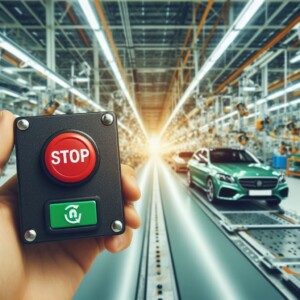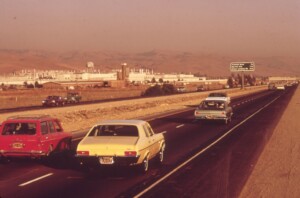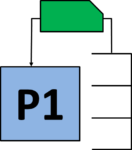 In industry, I often find the view that machines must run. The reasons given for this are that the machines were expensive investments, labor cost will accumulate, and the customer is waiting for products, hence the line must run. There is definitely some truth in this. However, the conclusion that the line must not stop is completely wrong. On the contrary, for the line (or the process in general) to run well, you MUST stop the line in certain circumstances. In this and the next post I would like to look in more detail at when you, rather than pressing forward with production (or rather, your operators), should stop the line. Let me explain.
In industry, I often find the view that machines must run. The reasons given for this are that the machines were expensive investments, labor cost will accumulate, and the customer is waiting for products, hence the line must run. There is definitely some truth in this. However, the conclusion that the line must not stop is completely wrong. On the contrary, for the line (or the process in general) to run well, you MUST stop the line in certain circumstances. In this and the next post I would like to look in more detail at when you, rather than pressing forward with production (or rather, your operators), should stop the line. Let me explain.
An Example on the Power of Stopping the Line (or Not)
 A good example on how NOT to run the line was provided the former GM Fremont plant in California, which later became the famous NUMMI GM–Toyota joint venture. Opened in 1961, it became the worst plant of GM, and of all of North America. Besides many, MANY other flaws, one of their bad rules was to never, ever stop the assembly line.
A good example on how NOT to run the line was provided the former GM Fremont plant in California, which later became the famous NUMMI GM–Toyota joint venture. Opened in 1961, it became the worst plant of GM, and of all of North America. Besides many, MANY other flaws, one of their bad rules was to never, ever stop the assembly line.
As a result, all problems were simply pushed downstream, resulting in hideous quality at the end of the line. Sometimes engines were installed backward; other cars had brakes or steering wheels missing. Some cars would be half of one model and another half of a completely different model. Many cars arrived at the end of the line incomplete or defective, unable to be driven, and had to be towed.
 Even in the case of accidents, the line did not stop. There were occasions of injured operators lying underneath of the line, yet they did not stop the line.
Even in the case of accidents, the line did not stop. There were occasions of injured operators lying underneath of the line, yet they did not stop the line.
Due to low morale, they also had the problem of large number of people not showing up. On average, one out of five people simply did not show up, with Mondays being considerably worse. Some days, when there were too few people to start the line, management simply hired people from the bar across the street on the spot so they could start the line. Of course, using untrained drunkards worsened quality even more and caused many more stops. Yet, despite their effort to always keep the line running, the line stopped frequently. The plant was eventually closed in 1982, and thousands of workers lost their jobs.
 In 1984, the plant was reopened as the New United Motor Manufacturing, Inc., better known as NUMMI, together with Toyota. Due to the influence by Toyota, things were run quite differently, and the plant soon became the best plant in North America, almost as good as the Toyota plants in Japan. And this with the same workforce to boot. However, the management had a very different mindset, and respect for employees was drastically improved, along with many other smaller and larger changes. One of the major differences was that now workers were not only allowed to stop the line but had to stop the line if there was a problem. Quality soared, cost went down, morale improved. Despite the explicit instructions to stop the line in case of problems, the line ran much more and much more stably than the old GM line ever did.
In 1984, the plant was reopened as the New United Motor Manufacturing, Inc., better known as NUMMI, together with Toyota. Due to the influence by Toyota, things were run quite differently, and the plant soon became the best plant in North America, almost as good as the Toyota plants in Japan. And this with the same workforce to boot. However, the management had a very different mindset, and respect for employees was drastically improved, along with many other smaller and larger changes. One of the major differences was that now workers were not only allowed to stop the line but had to stop the line if there was a problem. Quality soared, cost went down, morale improved. Despite the explicit instructions to stop the line in case of problems, the line ran much more and much more stably than the old GM line ever did.
There are a number of situations in modern manufacturing where stopping the line is much better than keeping it running. Let me give you an overview:
Stop the Line to Prevent Overproduction!
The first reason to stop the line is to prevent overproduction. Overproduction is one of the seven types of waste (in Japanese: muda). At Toyota it is considered the worst type of waste, as overproduction causes many subsequent types of waste. It creates excess inventory, with all the negatives associated with inventory, not only the cost of the inventory. You need to store, transport, and organize the inventory. Defects may increase during storage, or at least it takes longer to notice. Overall, you open a whole bag of troubles if you make more than you need.
However, it is also one of the hardest reasons to stop the line. Your workers WANT to make stuff. Ideally they are motivated and want to contribute to the success of the company by producing items. Even if not, they want to justify their wages by working rather than idling and waiting for work. I have seen examples of workers without production orders merely guessing what could be needed and starting to produce that merely so that they are not idle.
 I know of one plant that bought an expensive automatic production system. To justify the capital expenditure, this machine had to run as much as possible. Problem was, the customer was not buying enough. Unsurprisingly, they filled their warehouse to the brim. Then they bought the next warehouse and filled that to the brim too. Sometime during the third warehouse they finally got wiser, but then had roughly one year of unsold inventory that was getting out of fashion fast and hence was losing value. Completely unnecessarily, they maneuvered themselves into an inventory-trap corner that risked the survival of the company.
I know of one plant that bought an expensive automatic production system. To justify the capital expenditure, this machine had to run as much as possible. Problem was, the customer was not buying enough. Unsurprisingly, they filled their warehouse to the brim. Then they bought the next warehouse and filled that to the brim too. Sometime during the third warehouse they finally got wiser, but then had roughly one year of unsold inventory that was getting out of fashion fast and hence was losing value. Completely unnecessarily, they maneuvered themselves into an inventory-trap corner that risked the survival of the company.
Toyota even has something called AB control, where all processes stop if one process stops. On many assembly lines this is automatic, but if you have inventory in between, one process could run for quite some time before another process forces it to stop. AB control (among other things) also prevents overproduction.
 Hence, even if it is difficult mentally, your employees must stop the line if there is no need for the products to stop overproduction. The entire idea of kanban and pull production is to manage inventory and to prevent overproduction. In its ultimate form this is Just in Time (JIT) production.
Hence, even if it is difficult mentally, your employees must stop the line if there is no need for the products to stop overproduction. The entire idea of kanban and pull production is to manage inventory and to prevent overproduction. In its ultimate form this is Just in Time (JIT) production.
Preventing overproduction is one important reason to stop the line. But there are quite a few more. In my next post I will look into additional valid reasons to stop the line (or generally the production system). Sneak preview: You need to stop the line in case of problems, to put the focus on the problem, when there is a safety risk, to increase flexibility, and for maintenance. But more on this in my next post. Now, go out, stop your line if you don’t need the products, and organize your industry!


This is a very good article that focuses on the lack of understanding of another Toyota management principle called the Andon.
Definition: Andon is for any employee to call should the build in quality of the process be compromised which would lead to change in cycle time.
In other words, anyone, even the CEO can call the Andon.
Who is the Andon for: The Andon is there to protect the client.
What is the Andon as a principle: It is a fundamental culture building tool where quality is assured when the person calling the Andon knows they will be supported and appreciated.
Regards
Mark Forkun
Towards the end, you’ve touched on one of the less obvious issues with “just stop the line”. This is the fact that a stoppage in one section does not automatically force the upstream to stop or slow down at the same time. Even if we ignore the fact that some processes can not be stopped easily, this can make an already bad situation much worse.
The root of the mentality to never stop the line is caused by the daily production goals being calculated and set based on the absolute best case theoretical scenario, with no regard for any contingencies and ordinary daily production issues.
A closely related one is performance based pay tied to numbers goals set based on the same mentality.
One time I heard an anecdote of something that happened at a Tesla factory. A body panel press got a piece of debris stuck in a die and every panel unit was coming out with a dent. when the workers told the supervisor, the super said something like “screw it! Let the rework department deal with it because I am not taking a hit to my downtime KPIs”
Hello Andrew, good example from tesla on how NOT to do it. As for stopping the line: The preceding and following segments are decoupled by buffers, if these are full/empty respectively, they should stop, too 🙂
Line -stop is a central element of Toyota’s quality system. When Lean was extracted from TPS its importance was not appreciated. “Stopping the machine when there is trouble forces awareness on everyone. When a problem is clearly understood improvement is possible. As problems became clearer they showed me the direction to continue moving in.” Ohno. “It is a capital mistake to theorise before one has data & facts. … Insensibly one begins to twist facts to suit theories, instead of theories to suit facts.” – Sherlock Holmes. I use the following story to explain the power of line stop. I want you to solve a murder. There are two different methods you can choose. 1) You can be there when the murderer has just stuck the knife into the victim. The blood is running out of the wound & all the details of the event are visible. —- Or —- 2) Don’t go to the crime scene until 3 days after the stabbing & the blood is dry. The murderer has left the scene, & other than the body, no other details are visible. The main goal is now not to solve the problem, but to find who is to blame and cover our a###s. —– Been there done that! —- Which one would you chose? No brainer doesn’t come close. Line-stop also reinforces the Toyota long term view, they will lose production today to improve quality in the future,
Hello Christoph!
I’m so glad for this article! In my work I’m (not alone) in charge of WIP level and storages. The eagerness to produce for whatever cost, which you have described, is certainly apparent in our manufacturing peoples. But it’s hard to explain to them, that for the company, it’s better to stop. They have their means to continue production even without production orders. That’s to say, your article was somehow a relief to me. I will try to explain to managers tomorrow 🙂
Sincerely,
Karel
Hi Karel, i see it over and over again that “the machines/lines must run”, and then they are surprised that their inventory and its related cost goes through the roof…